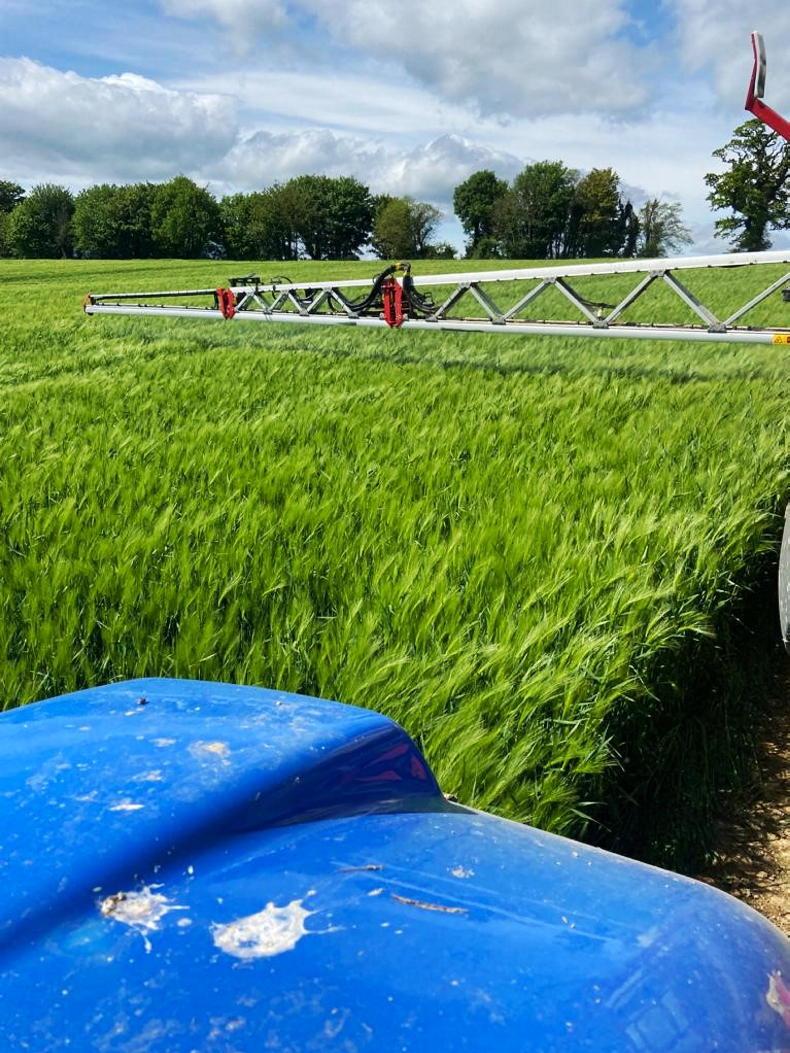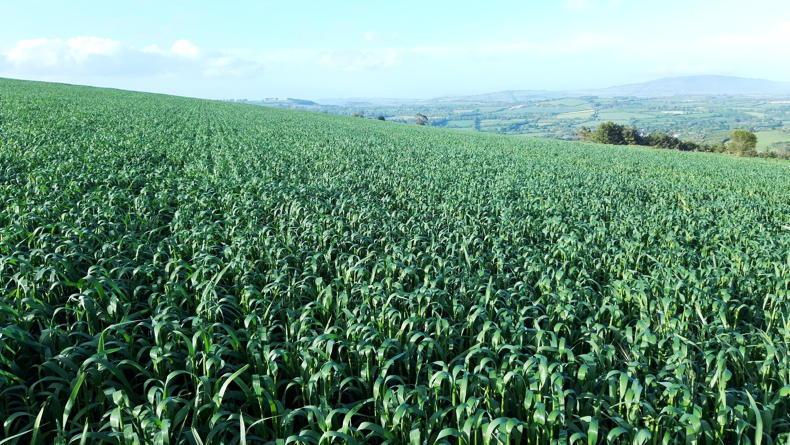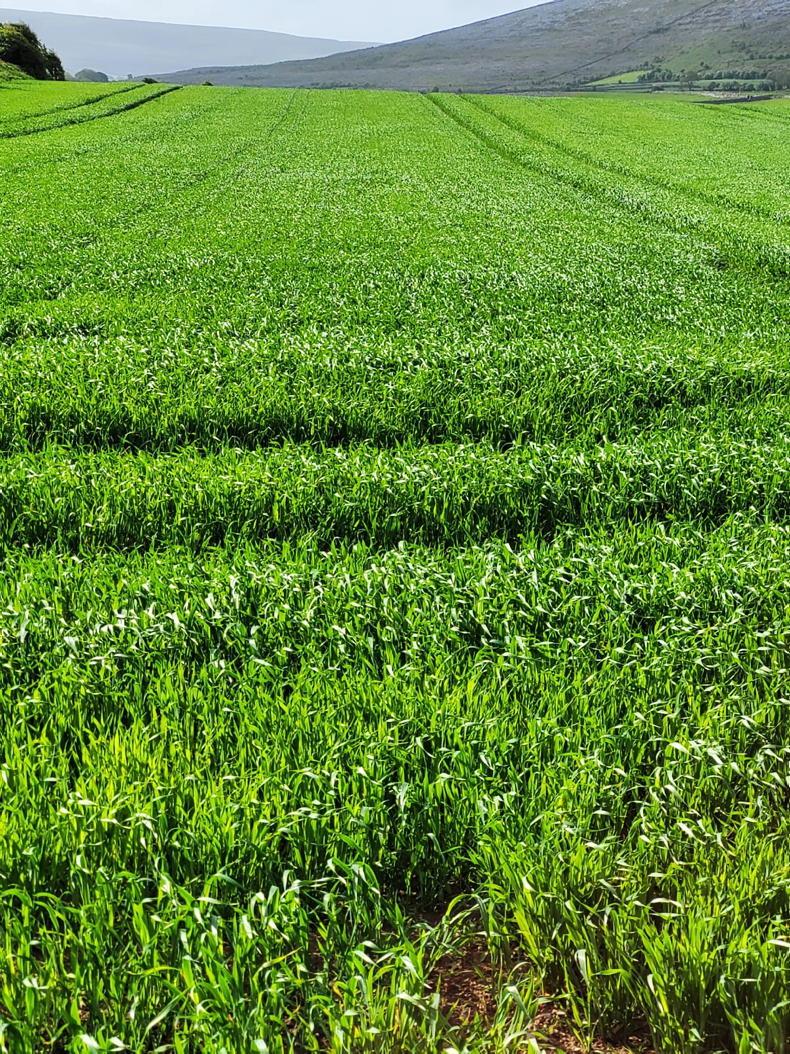Since talking to James last, the weather has turned much kinder in Tipperary. The cold, frosty nights are now gone and warm growthy conditions have returned. The arrival of rain was welcome, but James notes he is still well behind normal for the time of year.
His spring barley crops are developing well and are currently tillering. James applied a T1 fungicide last week of Boogie Xpro (1l/ha), as well as the growth regulator Medax Max (0.2kg/ha). The crops were brought up to 150kg N/ha.
James applied an aphicide on the crop, but did notice some yellow spots, which he thinks is BYDV.

James applying a head spray on winter barley.
His hybrid winter barley crops have fully headed out and received their head spray last week. The tank mix consisted of Decoy (0.4l/ha), Priaxor (0.8l/ha), Arizona (1l/ha) as well as Magniteh trace elements. He hopes the late application of trace elements will help with grain fill. The gates are now closed and the countdown is on to harvest.
Winter wheat
His winter wheat crops received a T2 fungicide over the weekend, which consisted of Arizona (1l/ha), Revystar (1.5l/ha) and Maginitech trace elements (1.5l/ha). He thinks the return of wet weather will increase disease pressure in what has been a relatively low-pressure year for him. James’s winter wheat crops, all of which are first wheats, were brought up to 200kg N/ha.
Having benefited from the rain, his winter oat crops are looking very well and stand at 150kg N/ha. Their final spray will consist of Elatus Era at 0.8l/ha. His hybrid winter rye is dark green in colour and has now headed out. The head spray consisted of Firefly (1.2l/ha) and Magnitech (2l/ha). The crop stands at 150kg N/ha.
His winter oilseed rape received their final fungicide spray 10 days ago of Filan at 0.4kg/ha. The bulk of the petals have now fallen. James and his agronomist David Quinlan take the opportunity to walk all crops this time of year and plan ahead for the coming season. While 2022’s prospects are looking good, much uncertainty remains for the 2023 season.
It’s been a cold and dry month in Wicklow, says Stuart, so the return of mild, moist weather this week was welcomed. He says that some spring crops in the area, especially those following grass, were showing signs of moisture stress until recently.
His spring barley crops are now looking well, as moisture has helped wash in nitrogen. However, he has noted some chickweed in crops, which will require a follow-up herbicide.
He has started T1 fungicides on his early crops, which consist of Coyote (0.6l/ha) as well as the herbicide Axial Pro (0.6l/ha).
He also added in a foliar feed mixture of Tri-Kelp seaweed, Dia Life and Triple Ten to help feed the crop.
Likewise, Stuart’s spring oats are developing well and will receive a foliar feed mixture shortly. His spring beans are moving along and received an application of Signum (0.5kg/ha) during the week.
Most of his winter barley crops received their first fungicide this week – Velogy Era (1l/ha) as well as Arizona (1l/ha) as a head spray.

Stuart's winter oat crops enjoying the sunshine.
Prior to this, the crop received foliar feed mixtures. Stuart is making a considerable saving on fungicide spend and the crop is indistinguishable from a conventionally grown crop, he says.
As a trial on one crop of winter barley, he applied 150kg N/ha as granular fertiliser and will apply 17kg N/ha as liquid urea in two splits. He wants to see if an overall reduced nitrogen application rate will affect yield.
He is also trialling the same strategy with a crop of winter wheat, however the majority of his crops have now been brought to 200kg N/ha. The crops are due a T2 fungicide this weekend, which will consist of Questar (2.1l/ha) and Arizona (1l/ha).
Stuart’s winter oat crops are starting to boot. Ten days ago, the crops received their first fungicide application of Decoy (0.5l/ha) and Comet (0.5l/ha).
Prior to this, they received three applications of a foliar feed mixture. His winter oilseed rape recently received a scelortinia spray of 0.5kg/ha of Filan, a foliar feed mixture and liquid urea.
The weather has been relatively good in Clare, says Shane. The recent rise in temperatures has increased crop and grass growth and he has been lucky to miss the worst of the thunder showers circulating this week.
While there has been some rain over the past few weeks, it hasn’t been heavy and ground conditions remain good. The countdown is on to the start of first-cut silage, which he expects to kick off by the weekend.
His Magnum fodder beet crops, which were sown nearly a month ago, are now emerging. He says that while temperatures are good now, nights were still cold until recently, which slowed crop emergence.
Shane ploughs the ground, discs, gathers stones with his Kivi Pekka trailed stone picker, discs again and applies fertiliser before drilling with an Armer Salmon drill on the flat. He drills on the flat as he is afraid drills could dry out too easily on his light soils during a dry spell.
The crops are due their first herbicide shortly, which will consist of Debut, Venzar, and Goltix. He may also add in Wolftrax Manganese.

Shane's spring oats are developing well.
His later-sown spring barley crops have emerged and are rapidly developing. They were top-dressed this week to bring the crop up to 162kg N/ha. They received a weed spray last week, which consisted of Cameo Max (45g/ha) and Binder (0.7l/ha). He also added the aphicide Markate (0.1l/ha) and the trace elements spray Cereal Aloy (1.2l/ha) into the tank.
Shane thinks these crops aren’t too far behind his earlier-sown spring barley crops, which have also been brought to 162kg N/ha. His spring oats are also developing very well, having been brought to 100kg N/ha.
The crop received the same herbicide as his spring barley, as well as 240g/ha of Wolftrax Manganese. His winter barley crops are now due a head spray and are looking well. Shane thinks the cost of diesel and fluctuations in prices are going to be a real issue for contractors this silage season.
Since talking to James last, the weather has turned much kinder in Tipperary. The cold, frosty nights are now gone and warm growthy conditions have returned. The arrival of rain was welcome, but James notes he is still well behind normal for the time of year.
His spring barley crops are developing well and are currently tillering. James applied a T1 fungicide last week of Boogie Xpro (1l/ha), as well as the growth regulator Medax Max (0.2kg/ha). The crops were brought up to 150kg N/ha.
James applied an aphicide on the crop, but did notice some yellow spots, which he thinks is BYDV.

James applying a head spray on winter barley.
His hybrid winter barley crops have fully headed out and received their head spray last week. The tank mix consisted of Decoy (0.4l/ha), Priaxor (0.8l/ha), Arizona (1l/ha) as well as Magniteh trace elements. He hopes the late application of trace elements will help with grain fill. The gates are now closed and the countdown is on to harvest.
Winter wheat
His winter wheat crops received a T2 fungicide over the weekend, which consisted of Arizona (1l/ha), Revystar (1.5l/ha) and Maginitech trace elements (1.5l/ha). He thinks the return of wet weather will increase disease pressure in what has been a relatively low-pressure year for him. James’s winter wheat crops, all of which are first wheats, were brought up to 200kg N/ha.
Having benefited from the rain, his winter oat crops are looking very well and stand at 150kg N/ha. Their final spray will consist of Elatus Era at 0.8l/ha. His hybrid winter rye is dark green in colour and has now headed out. The head spray consisted of Firefly (1.2l/ha) and Magnitech (2l/ha). The crop stands at 150kg N/ha.
His winter oilseed rape received their final fungicide spray 10 days ago of Filan at 0.4kg/ha. The bulk of the petals have now fallen. James and his agronomist David Quinlan take the opportunity to walk all crops this time of year and plan ahead for the coming season. While 2022’s prospects are looking good, much uncertainty remains for the 2023 season.
It’s been a cold and dry month in Wicklow, says Stuart, so the return of mild, moist weather this week was welcomed. He says that some spring crops in the area, especially those following grass, were showing signs of moisture stress until recently.
His spring barley crops are now looking well, as moisture has helped wash in nitrogen. However, he has noted some chickweed in crops, which will require a follow-up herbicide.
He has started T1 fungicides on his early crops, which consist of Coyote (0.6l/ha) as well as the herbicide Axial Pro (0.6l/ha).
He also added in a foliar feed mixture of Tri-Kelp seaweed, Dia Life and Triple Ten to help feed the crop.
Likewise, Stuart’s spring oats are developing well and will receive a foliar feed mixture shortly. His spring beans are moving along and received an application of Signum (0.5kg/ha) during the week.
Most of his winter barley crops received their first fungicide this week – Velogy Era (1l/ha) as well as Arizona (1l/ha) as a head spray.

Stuart's winter oat crops enjoying the sunshine.
Prior to this, the crop received foliar feed mixtures. Stuart is making a considerable saving on fungicide spend and the crop is indistinguishable from a conventionally grown crop, he says.
As a trial on one crop of winter barley, he applied 150kg N/ha as granular fertiliser and will apply 17kg N/ha as liquid urea in two splits. He wants to see if an overall reduced nitrogen application rate will affect yield.
He is also trialling the same strategy with a crop of winter wheat, however the majority of his crops have now been brought to 200kg N/ha. The crops are due a T2 fungicide this weekend, which will consist of Questar (2.1l/ha) and Arizona (1l/ha).
Stuart’s winter oat crops are starting to boot. Ten days ago, the crops received their first fungicide application of Decoy (0.5l/ha) and Comet (0.5l/ha).
Prior to this, they received three applications of a foliar feed mixture. His winter oilseed rape recently received a scelortinia spray of 0.5kg/ha of Filan, a foliar feed mixture and liquid urea.
The weather has been relatively good in Clare, says Shane. The recent rise in temperatures has increased crop and grass growth and he has been lucky to miss the worst of the thunder showers circulating this week.
While there has been some rain over the past few weeks, it hasn’t been heavy and ground conditions remain good. The countdown is on to the start of first-cut silage, which he expects to kick off by the weekend.
His Magnum fodder beet crops, which were sown nearly a month ago, are now emerging. He says that while temperatures are good now, nights were still cold until recently, which slowed crop emergence.
Shane ploughs the ground, discs, gathers stones with his Kivi Pekka trailed stone picker, discs again and applies fertiliser before drilling with an Armer Salmon drill on the flat. He drills on the flat as he is afraid drills could dry out too easily on his light soils during a dry spell.
The crops are due their first herbicide shortly, which will consist of Debut, Venzar, and Goltix. He may also add in Wolftrax Manganese.

Shane's spring oats are developing well.
His later-sown spring barley crops have emerged and are rapidly developing. They were top-dressed this week to bring the crop up to 162kg N/ha. They received a weed spray last week, which consisted of Cameo Max (45g/ha) and Binder (0.7l/ha). He also added the aphicide Markate (0.1l/ha) and the trace elements spray Cereal Aloy (1.2l/ha) into the tank.
Shane thinks these crops aren’t too far behind his earlier-sown spring barley crops, which have also been brought to 162kg N/ha. His spring oats are also developing very well, having been brought to 100kg N/ha.
The crop received the same herbicide as his spring barley, as well as 240g/ha of Wolftrax Manganese. His winter barley crops are now due a head spray and are looking well. Shane thinks the cost of diesel and fluctuations in prices are going to be a real issue for contractors this silage season.









 This is a subscriber-only article
This is a subscriber-only article










SHARING OPTIONS: